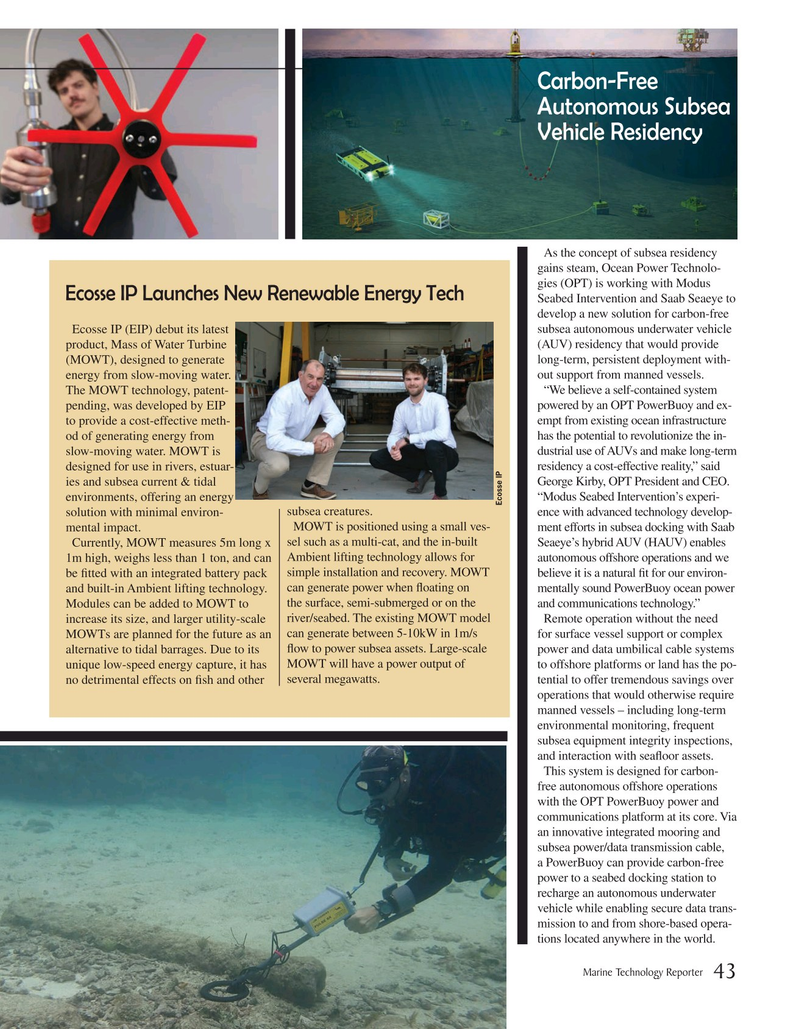
Page 43: of Marine Technology Magazine (April 2020)
Read this page in Pdf, Flash or Html5 edition of April 2020 Marine Technology Magazine
Carbon-Free
Autonomous Subsea
Vehicle Residency
As the concept of subsea residency gains steam, Ocean Power Technolo- gies (OPT) is working with Modus
Ecosse IP Launches New Renewable Energy Tech
Seabed Intervention and Saab Seaeye to develop a new solution for carbon-free
Ecosse IP (EIP) debut its latest subsea autonomous underwater vehicle product, Mass of Water Turbine (AUV) residency that would provide (MOWT), designed to generate long-term, persistent deployment with- energy from slow-moving water. out support from manned vessels.
The MOWT technology, patent- “We believe a self-contained system pending, was developed by EIP powered by an OPT PowerBuoy and ex- to provide a cost-effective meth- empt from existing ocean infrastructure od of generating energy from has the potential to revolutionize the in- slow-moving water. MOWT is dustrial use of AUVs and make long-term designed for use in rivers, estuar- residency a cost-effective reality,” said ies and subsea current & tidal George Kirby, OPT President and CEO. environments, offering an energy “Modus Seabed Intervention’s experi-
Ecosse IP solution with minimal environ- subsea creatures. ence with advanced technology develop- mental impact. MOWT is positioned using a small ves- ment efforts in subsea docking with Saab
Currently, MOWT measures 5m long x sel such as a multi-cat, and the in-built Seaeye’s hybrid AUV (HAUV) enables 1m high, weighs less than 1 ton, and can Ambient lifting technology allows for autonomous offshore operations and we be ftted with an integrated battery pack simple installation and recovery. MOWT believe it is a natural ft for our environ- and built-in Ambient lifting technology. can generate power when foating on mentally sound PowerBuoy ocean power
Modules can be added to MOWT to the surface, semi-submerged or on the and communications technology.” increase its size, and larger utility-scale river/seabed. The existing MOWT model Remote operation without the need
MOWTs are planned for the future as an can generate between 5-10kW in 1m/s for surface vessel support or complex alternative to tidal barrages. Due to its fow to power subsea assets. Large-scale power and data umbilical cable systems unique low-speed energy capture, it has MOWT will have a power output of to offshore platforms or land has the po- no detrimental effects on fsh and other several megawatts. tential to offer tremendous savings over operations that would otherwise require manned vessels – including long-term environmental monitoring, frequent subsea equipment integrity inspections, and interaction with seafoor assets.
This system is designed for carbon- free autonomous offshore operations with the OPT PowerBuoy power and communications platform at its core. Via an innovative integrated mooring and subsea power/data transmission cable, a PowerBuoy can provide carbon-free power to a seabed docking station to recharge an autonomous underwater vehicle while enabling secure data trans- mission to and from shore-based opera- tions located anywhere in the world. www.marinetechnologynews.com
Marine Technology Reporter 43

 42
42

 44
44
